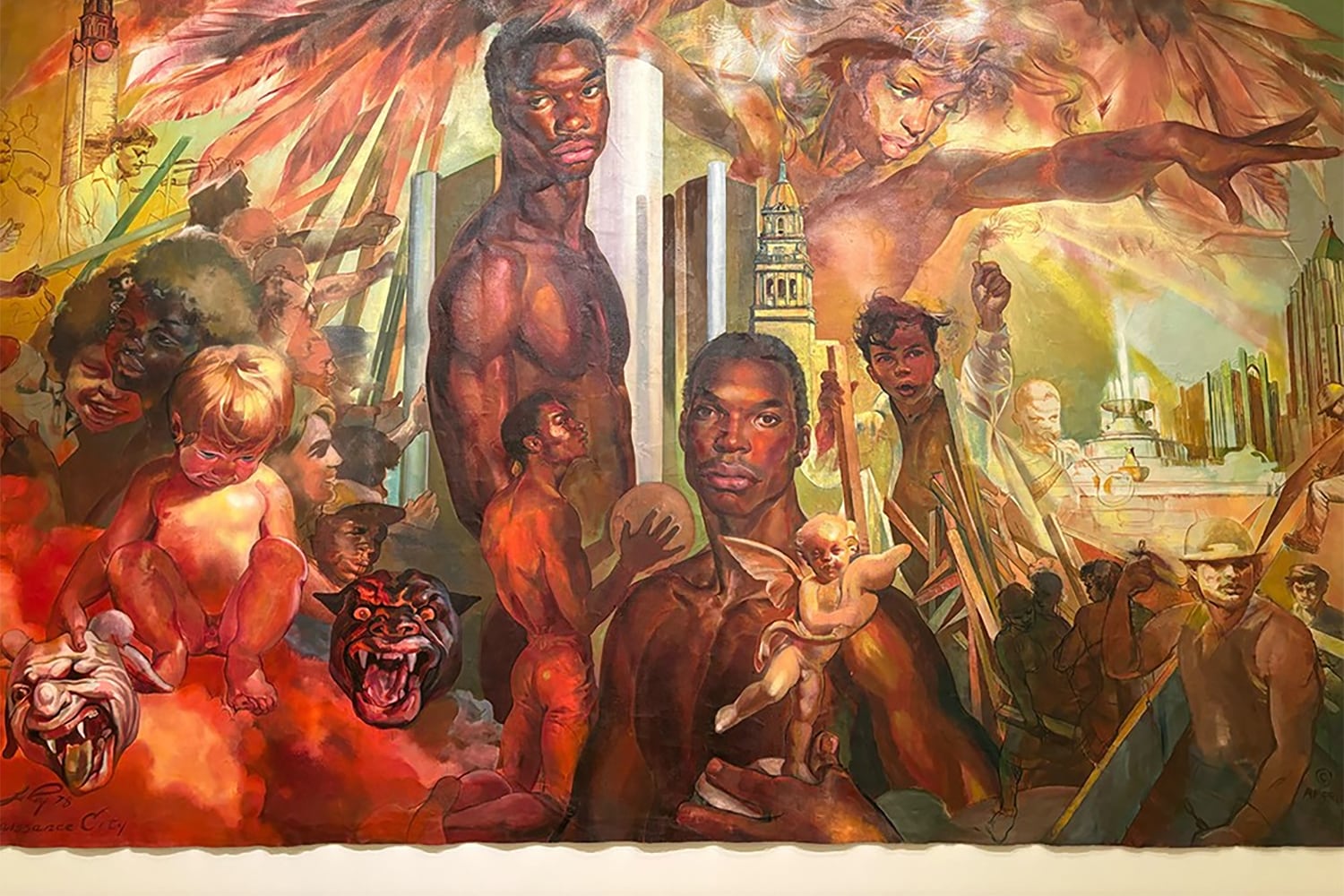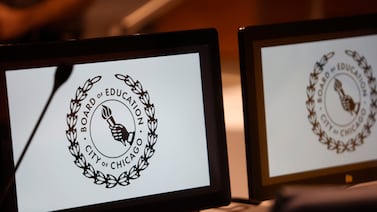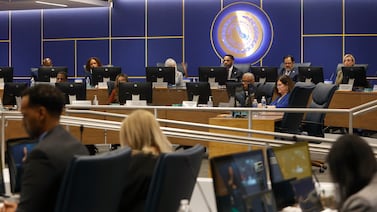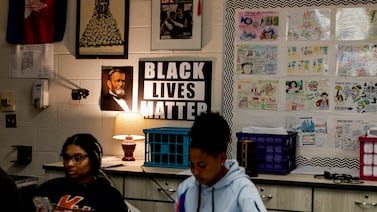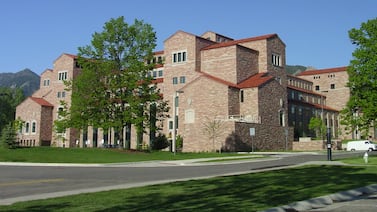A thick haze hung in the air of the old Cass Technical High School as a mask-clad Senghor Reid crept through its forgotten hallways. Extension cords ran from room to room as squatters made the abandoned building home, sucking out the last bits of electricity and warmth left within its walls. Reid, along with fellow art teachers William Tyus, Mindy Mitchell, and others, had broken into the school to save student artwork and supplies before the building was to be demolished. One of them donned a hazmat suit. The air quality was so poor the place looked like a steam room.
The crew braved the dark building for only about 30 minutes, but when they came across LeRoy Foster’s “Renaissance City” — a large-scale painting that had been displayed in the cafeteria — they knew they had to save it, too. They rolled the painting up, got the hell out of there, and stored it on top of a cabinet at the new Cass Tech erected next door. They didn’t tell anyone aside from other teachers about breaking into the building and rescuing Foster’s painting.
That was back in 2006, shortly after the former Cass Tech closed in 2005. As far as most Detroiters and legions of former “Technicians” were concerned, “Renaissance City” had been lost in the rubble when the old building was torn down.
“It was a smash and grab kind of thing,” Reid tells Metro Times, recalling they had a short window of opportunity to rescue the artwork before the building came down. “We kept it safe and there was a plan for us to one day raise enough money to have the piece restored but, you know, that kind of got put on the back burner, and life went on. We were just excited that we saved it knowing one day something will happen and we’ll be able to maybe put it up in the new building somewhere.”
“Renaissance City” sat secretly tucked away in Cass Tech’s drawing studio for 17 years. It’s finally on display again as part of a retrospective of Foster’s work at Cranbrook Art Museum called “LeRoy Foster: Solo Show.” The show runs in tandem with a group exhibition of contemporary Black Detroit artists, including Reid, titled “Skilled Labor: Black Realism in Detroit.” Both shows opened on Oct. 28 and were curated by Mario Moore, whose work also appears in “Skilled Labor,” and Cranbrook Art Museum chief curator Laura Mott.
Mott calls both exhibits and the way they came together an exercise in “Detroit divinity.” While she and Moore were doing research for the LeRoy Foster show, Reid told them how he and his fellow teachers had saved “Renaissance City,” which depicts Detroit’s revival after the 1967 Rebellion.
“We went down to the (Detroit Public Library Douglass Branch) because LeRoy has a huge mural there. They have a packet of information on him and what they have for (‘Renaissance City’) is that it had been destroyed,” Mott says. “But Senghor had mentioned to Mario like, ‘You know, we saved that mural.’ … It had been rolled up for, I don’t know, 16 years, and no one had seen it. So Mario went and unrolled it with the current students, which was great, but it had sustained some damage.”
Mott asked Rochelle Riley, director of arts and culture for the City of Detroit, to help with the $7,000 restoration, and her office obliged. In 2022, Detroit’s Office of Arts, Culture, and Entrepreneurship co-sponsored a monthlong exhibit of queer artists during Pride month called “Mighty Real/Queer Detroit” in which Foster was prominently featured. It took over 17 venues across the city with work by over 150 LGBTQ+ artists and sparked a renewed interest in Foster’s work.
Foster was a prominent painter in Detroit in the 1950s and 1960s and is often referred to as “The Michelangelo of Detroit.” Despite his talent and notoriety within the Detroit arts community, his work didn’t receive the recognition it deserved while he was still alive, and this is the first solo show of his work in a museum. During his heyday, Foster also performed as drag queen Martini Marti.
“All of the things that we’re doing now with support, and money, and collectors, LeRoy Foster was doing 70 years ago with none of that,” Reid says. “He was doing it out of the sheer will and determination of his character. He had collectors, but he didn’t have a gallery, Cranbrook, or the DIA showing his work in the ’40s and ’50s … There are forces who did not necessarily want to see this show happen and did not want the mural to be preserved, and so I’m just happy that there’s a large institution that stepped in trying to do something to support the legacy of one of the most important Black artists that Detroit has ever seen.”
In “Skilled Labor: Black Realism in Detroit,” we see Detroit’s contemporary Black artists receive their due praise while they’re still around. The show features 20 of Detroit’s best Black artists across generations from scene veterans like Hubert Massey and Richard Lewis to young painters like Bakpak Durden, Jonathan Harris, Ijania Cortez, and Cailyn Dawson.
It also features work by Christopher Batten, Taurus Burns, Cydney Camp, Conrad Egyir, Sydney G. James, Gregory Johnson, Sabrina Nelson, Patrick Quarm, Joshua Rainer, Jamea Richmond-Edwards, Rashaun Rucker, and Tylonn J. Sawyer.
It’s the best showcase of Detroit’s Black excellence in one place we’ve seen in years, like the city’s own Rock & Roll Art Hall of Fame, with LeRoy Foster standing watch as a guardian ancestor.
The museum feels full of life, like the artists are standing right there beside us when we visit, and they are — in the form of self-portraits and “anti-portraits” wherein the artist is portrayed turned slightly (or entirely) away from the viewer. In Cydney Camp’s work she often appears with her back turned, a distorted figure seen yet unknown. It’s as if the artists want us to see them, to acknowledge their presence and humanity, but not to trespass on their autonomy.
In a book published for the exhibit, the artists discuss the idea of “anti-portraits” at length. In one section Bakpak said, “I don’t consider the gaze at all. In fact, I’m never making eye contact. I’m never looking. It’s not voyeurism. It’s more like a viewer entering into a world. There becomes a level of compassion with the story that’s being told instead of there being a separation between you and what you’re viewing. You may not understand fully my experience in this temporal world, but I’m offering you the opportunity and my consent to explore.”
Everywhere you look in the “Skilled Labor” and LeRoy Foster show, you see connections. Richard Lewis is one of Moore’s early mentors. Sydney G. James is a mentor to Ijania Cortez and Bakpak Durden. James, Christopher Batten, Moore, and several others graduated from Cass Tech (and so did I), and Reid used to teach there.
When I run into Batten at the museum, he tells me he vividly remembers seeing “Renaissance City” in the old school’s cafeteria when he was a student from 1996 to 2000. His cousin also had a print of Foster’s “Madonna and Child” drawing at his barber shop, which is part of the Cranbrook show.
“He had that print in his booth, and I remember when I saw that at 5 years old, it just blew my mind,” he tells Metro Times. “I credit that image as one of the things that made me want to be an artist.”
This is the first time he’s seen “Madonna and Child” again since his childhood.
“When I was a kid, I just couldn’t fathom a human being able to do something like that because I was drawing my Ninja Turtles and all that stuff thinking I’m doing something,” he says laughing. “It’s like, you know when people try to say aliens helped build the pyramids? I’m like, aliens must have helped that guy draw that. I just couldn’t believe it. It was just instantly a symbol of artistic excellence.”
Reid says many of Detroit’s Black figurative painters owe Foster a great deal of gratitude for influencing their style, even if they don’t know it.
“In my generation and the generation of artists before me, we knew LeRoy Foster’s work, but LeRoy Foster as a person was still kind of this enigma,” he says. “But I feel like it gave us strength to know that there was this artist who was doing his thing 30, 40 years ago. So many artists, especially figurative and realist painters in Detroit, really built the ‘Detroit style’ on the foundation that he helped build because after him you have artists like John (Onye Lockard) and Carl Owens who followed him in wanting to create black heroic figures in art.”
He adds, “In the ’60s and ’70s you had artists like my mom (Shirley Woodson and Allie McGhee and artists coming out of the Black Arts Movement. But before them, LeRoy Foster was the biggest name of a Black artist in Detroit.”
Batten agrees, saying, “I think it’s fair to say that even on an unconscious level, he’s one of my influences, so to be in the same space as him, I’m just humbled. I’ve never seen as much of his work in the same place.”
“Skilled Labor” and “LeRoy Foster: Solo Show” are part of Cranbrook Art Museum’s fall season, which also includes Carl Toth’s “Reordering Fictions” and Ash Arder’s “Flesh Tones.”
When the LeRoy Foster show closes in March of 2024, “Renaissance City” will be given back to Cass Tech, and Mott hopes the school decides to put it back on display to inspire future generations of Detroit artists.
Randiah Camille Green is a reporter for Detroit Metro Times. You can reach her at randiah@metrotimes.com.

